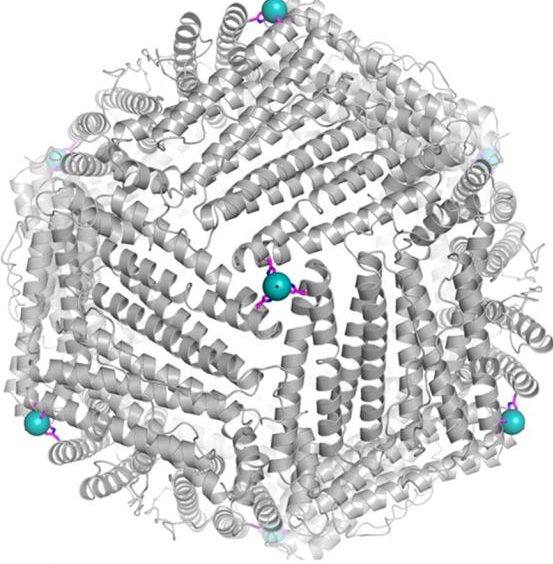Modular Construction on a Biomolecular Scale
08/25/2015

A cage-like protein (gray) called ferritin was engineered to have metal hubs (blue) on its surface. Organic molecules (purple) can bridge these metal hubs, controllably creating a porous, crystalline material with potential applications ranging from catalysis to separations. [Credit: A. Sontz, et al. J. Am. Chem. Soc. (2015) DOI: 10.1021/jacs.5b07463]
The Summary
The spherical protein ferritin was used to synthesize a porous 3-D crystalline framework material, and further engineered to have metal hubs on its surface. Organic molecules bridge these hubs, and in a controlled way create a porous material with potential uses from efficient fuel storage to carbon capture and conversion. The study shows the great potential for proteins as building blocks with exquisite properties of electron transfer and bioinspired catalysis.
Funding
Work supported by the Office of Basic Energy Sciences (OBES) Division of Materials Sciences, U.S. Department of Energy (DOE) Office of Science, Award DE-FG02-10ER46677 to F.A.T. Crystallographic data collected at Stanford Synchrotron Radiation Laboratory (SSRL), SLAC National Accelerator Laboratory (SLAC), supported by two DOE offices: OBES and OBER, as well as by the National Institutes of Health (NIH). Coordinate and structure factor files deposited into Protein Data Bank under accession numbers 5CMQ and 5CMR.
Related Links
- BER Resource: Structural Molecular Biology Resource
- Feature Story: Modular construction on a molecular scale
- Press release from Science Daily
References
A. Sontz, J. B. Bailey, S. Ahn and F. A. Tezcan, “A Metal Organic Framework with Spherical Protein Nodes: Rational Chemical Design of 3D Protein Crystals”, J. Am. Chem. Soc. 137, 11598 (2015). [DOI: 10.1021/jacs.5b07463]
